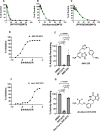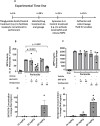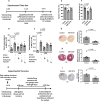Targeting vascular adhesion protein-1 and myeloperoxidase with a dual inhibitor SNT-8370 in preclinical models of inflammatory disease
- PMID: 40210617
- PMCID: PMC11985910
- DOI: 10.1038/s41467-025-58454-6
Targeting vascular adhesion protein-1 and myeloperoxidase with a dual inhibitor SNT-8370 in preclinical models of inflammatory disease
Abstract
Inflammatory diseases are a major source of morbidity and mortality world-wide, the pathogenesis of which are characterised by the interplay of key pro-inflammatory and oxidative enzymes. Here, we report the development of a small molecule dual inhibitor targeting vascular adhesion protein-1 (VAP-1) and myeloperoxidase (MPO), two clinically relevant pro-inflammatory/oxidative enzymes that play complementary pathogenic roles in various inflammatory diseases. This agent, SNT-8370 [(E)-3-(3-((2-(aminomethyl)-3-fluoroallyl)oxy)benzyl)-2-thioxo-1,2,3,7-tetrahydro-6H-purin-6-one)], irreversibly inhibits VAP-1 and MPO activity with equivalent and enhanced nanomolar potency, respectively, when compared to benchmark clinical VAP-1 and MPO inhibitors. SNT-8370 is selective, exhibiting >100-1000-fold more potency for VAP-1 and MPO versus other mammalian (per)oxidases and shows no significant off-target activity in established preclinical screening panels. In vivo, SNT-8370 is metabolically stable, exhibits a favourable pharmacokinetic/pharmacodynamic profile without CNS penetration, and effectively inhibits VAP-1 and MPO activities. Moreover, compared to monotherapy, SNT-8370 more effectively inhibits leukocyte infiltration in mouse peritonitis, carrageenan air pouch, and lipopolysaccharide-induced lung injury models of acute inflammation. SNT-8370 is also protective in preclinical models of myocardial ischemia-reperfusion injury and unilateral-ureteral-obstruction-induced nephropathy. Collectively, our results support SNT-8370 as a first-in-class, mechanism-based dual inhibitor of VAP-1 and MPO, and as a promising therapeutic for the clinical treatment of inflammatory disorders.
© 2025. The Author(s).
Conflict of interest statement
Competing interests: This study was partly funded by research support of Syntara Limited, Australia (formerly Pharmaxis Limited) to UNSW (S.R.T., E.G.), UFMG (M.M.T.), Heart Research Institute (B.R.) and the University of Otago (M.P.P.). Throughout the course of the work, J.F., H.S. and W.J. were employed by Syntara Limited, and held shares in the company. The remaining authors declare no competing interests.
Figures








Similar articles
-
Vascular adhesion protein-1 enhances neutrophil infiltration by generation of hydrogen peroxide in renal ischemia/reperfusion injury.Kidney Int. 2017 Jul;92(1):154-164. doi: 10.1016/j.kint.2017.01.014. Epub 2017 Mar 17. Kidney Int. 2017. PMID: 28318627
-
PXS-4681A, a potent and selective mechanism-based inhibitor of SSAO/VAP-1 with anti-inflammatory effects in vivo.J Pharmacol Exp Ther. 2013 Nov;347(2):365-74. doi: 10.1124/jpet.113.207613. Epub 2013 Aug 13. J Pharmacol Exp Ther. 2013. PMID: 23943052
-
Effects of an anti-inflammatory VAP-1/SSAO inhibitor, PXS-4728A, on pulmonary neutrophil migration.Respir Res. 2015 Mar 20;16(1):42. doi: 10.1186/s12931-015-0200-z. Respir Res. 2015. PMID: 25889951 Free PMC article.
-
Vascular Adhesion Protein-1: A Cell Surface Amine Oxidase in Translation.Antioxid Redox Signal. 2019 Jan 20;30(3):314-332. doi: 10.1089/ars.2017.7418. Epub 2017 Dec 7. Antioxid Redox Signal. 2019. PMID: 29065711 Free PMC article. Review.
-
Vascular adhesion protein-1 and microvascular diabetic complications.Pharmacol Rep. 2022 Feb;74(1):40-46. doi: 10.1007/s43440-021-00343-y. Epub 2022 Jan 10. Pharmacol Rep. 2022. PMID: 35001320 Review.
References
-
- Monteleone, G., Moscardelli, A., Colella, A., Marafini, I. & Salvatori, S. Immune-mediated inflammatory diseases: common and different pathogenic and clinical features. Autoimmun. Rev.22, 103410 (2023). - PubMed
MeSH terms
Substances
LinkOut - more resources
Full Text Sources
Research Materials
Miscellaneous

